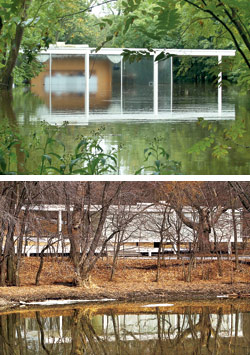
The Fox River was still rising, so Whitney French pulled on her fireman’s boots and sprang into action. French is the site director of Farnsworth House, the architectural shrine in Plano, and she was moving “flood remediation tools,” decidedly low-tech items such as milk crates, duct tape, and two-by-sixes, to Ludwig Mies van der Rohe’s crystalline glass structure.
Just last spring, French had practiced the same drill after a broken dam in Aurora threatened high water that didn’t come. This time, the downpour of Saturday, September 13th, caused the river near Plano in Kendall County to overflow. By that afternoon, French was scurrying around the landmark as water surrounded the house. A groundskeeper came to her rescue in a boat, but not before French got two dozen pieces of museum-quality furniture raised on crates, out of harm’s way. Then 18 inches of murky river came rushing inside.
Many local residents fought similar battles that weekend. A minimum of 2,500 homes were flooded by the Fox and other rivers in the metro area, according to the Illinois Emergency Management Agency. Experts point to increased amounts of rain, but nature is only partly to blame. Increased development has led to more pavement and less soil, which, in turn, has caused swift runoff in watersheds along the Fox River in Kane and Kendall counties in particular. Now the problem is worsening along the Des Plaines and Chicago rivers.
Starting with the big flood of 1996, when Farnsworth took in more than five full feet of water, floods have hit the Chicago region with more frequency and widespread impact. Most homeowners can do only so much: Some clear their basements; others buy canoes. But Farnsworth House is different from a tract house in Kane County or a bungalow along the Chicago River. The 57-year-old house, which the New Yorker critic Paul Goldberger recently called the “ultimate expression of architectural genius,” was built to resist high water. By design, it sits on five-foot pylons, partially to render its otherworldly, gravity-defying appearance. But more to Mies’s quintessentially rational point: pylons, steel frame, and travertine pavements were intended to resist even the highest “100-year” floods, which Mies guessed would never rise higher than the raised floor.
Illustration by Mario Wagner
|
|
Mies couldn’t have predicted that sprawl would cause higher and more frequent floods—and now the guardians of Farnsworth are looking for protection as unique as the house itself. One distinguished Chicago architect, famous for his own innovative architecture, suggested that, in high water, the preservationists who curate the house should detach Farnsworth from its pylons and float it to safety. Others have suggested that the house be moved permanently to high ground; this faction contends that it should have been built beyond the floodplain to begin with.
Jim Peters, the president of Landmarks Illinois, which manages the house/museum, says neither solution will fix the problem. First, floating a house that weighs an estimated 300 tons is illogical, he says. Moving it from the original site, he adds, is unthinkable. “That would destroy the meaning of the house.”
Another proposal: to build a conventional levee system akin to the one along the Mississippi River. But Peters says that idea is incompatible with the architecture, since the house he’s trying to protect represents an “organic” response to the lay of the land. Building mounds around it would be like enclosing the Acropolis in glass to protect the Parthenon.
Someone else has suggested using a trademarked “Invisible Flood Control Wall” from a company in Massachusetts. With metal sections that slide in on a concrete foundation, the wall would go up only when needed and then come down. But the cost goes way north of a million. And it could take ten hours to slide the panels into place; a high-water surge often gives warning of half that time.
In the modernist spirit of “Less is more” (or “Less is more expensive”), someone else has proposed putting the eight pylons on invisible hydraulic lifts, raising the house from danger with the flick of a switch. Problem #1: unimaginable cost. Problem #2: If one of the lifts was off by even a fraction of an inch, the house could torque and the glass explode like in a scene from Independence Day.
What would Mies do? architects are tempted to ask. Probably laugh at another proposal, which is wrapping the house in “a giant Ziploc bag.” Actually, curators say this one deserves a closer look. Peters points out that a Swedish company makes such a product. But still there’s the problem of equalizing pressure on both sides of the glass. Proposed solution: filling the sealed interior with clean water when the river hits flood level.
Landmarks Illinois estimates the cleanup costs from the September flood will top $100,000, perhaps by quite a lot. Once that’s settled, the organization will embark on a formal study of all the likely ways they can protect the house, and measure the proposals according to aesthetics and economics. By issuing a call for ideas, they’re hoping that new approaches to flood protection will emerge.
It’s possible that there isn’t an ideal solution. Perhaps the guardians of Farnsworth should do nothing beyond investing in more milk crates and mops as well as a good insurance policy. This straightforward approach appeals to John Bryan, former CEO of Sara Lee, who worked as a major donor in 2003 when the house was purchased for $7.5 million. If other solutions cannot be justified, Bryan points out, a design of glass, steel,
and stone makes Farnsworth’s exterior eminently water-resistant. “Mies thought about this in advance,” Bryan says. “He just didn’t get it quite high enough.”
Photography: (top) Courtesy of Landmarks Illinois, (bottom) John Kringas/Chicago Tribune



